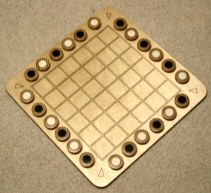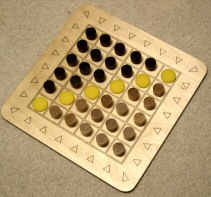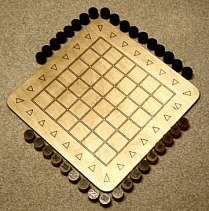 |
 Game Profile —
Game Profile —
Six-by-Six, a family of games
by Kate Jones



This year, 2007, marks the 25th anniversary of one of our classic boardgames—Leap—and the first anniversary of its rebirth as part of a trilogy of game systems played on a 6x6 grid. This size of board is very versatile and lends itself to many interesting explorations.
When Christopher Clark, one of our talented game designers, came up with a couple of new games to play on a 6x6 board, it was the most natural thing to marry them to our existing equipment. And because Chris's game needed some arrows on the edges, the logical step was to redesign the whole kit to have the arrows, and to add the separate set of Chris's special checkers, 12 per player (half of them with a green mark on the reverse and the other half blank). We'd, of course, keep the Leap numbered disks for all the Leap activities. Two sets of pieces, 2 rule books, one handsome, laser-engraved wood board.
Just about that time, Stephen Sniderman, a prolific inventor of word and number games and puzzles, presented us with a wonderful surprise: an ensemble of 25 games in honor of our 25th anniversary. He called them Take a Number, and they just happened to need numbered pieces from 1 to 25. The trilogy was complete. An umbrella name, Six-by-Six, covered one board, 2 sets of pieces, 3 books, and at least 32 games and 55 series of solitaires.
With such a wealth of material to explore, one will never run out of challenges and lively entertainment. Here are the highlights from each of the three books:



Reveal and Hmm...
by Christopher Clark
In Reveal, the two players randomly place their pieces upside down on the board, with 14 along the borders and 10 on the interior. They then reverse 5 pieces each to reveal whose pieces they are. Thus each game has a totally different beginning, and not necessarily an even one. Of course, if one player feels greatly shortchanged, a reshuffle can be requested.
Once the start position is established, players take turns doing three things on each turn: 1) Moving any piece showing a green dot, like a chess queen, to another space on the board. 2) Making one or more jumps with one of their pieces over other pieces of any color or type; removing any jumped-over face-up piece from the board, including their own. Blank pieces stay put. 3) Turning over any one blank checker to reveal whose it is.
A jumping move may land on an arrow outside the board, which ends the moves, and the outside piece is repositioned to the interior in any empty space the player chooses.
These options set up deliciously devious strategies for removing the other player's pieces from the board. When only your color is showing, you win.
For Hmm..., start the checkers alternating colors around the edge (left picture above). They then move inward along open rows. Goal: form a row of four of one color in any direction. Once on the field, pieces may move one step rook-like. Deep and subtle, how to block, how to set up a two-way win. Simply beautiful, and always different.



Leap
by Kate Jones
Five games explore leaps of all kinds:
-
Leap Over — get your 12 pieces to the other side, like Chinese Checkers, except for a catch: each move must be a jump. Get a piece stranded, bring others back to rescue it.
-
Leap Plus — start with empty board. Take turns placing disks on the grid in numerical order from 1. First player may place on any square. Moves thereafter are placed next to the last disk played, which then leaps over the new one. Last player able to add a number and leap over it is the winner.
-
Knight's Tourney — start with board set up as shown in middle picture above, with 15 inverted (number side down) disks for each player, light and dark teams, and the center line covered with the 6 blanks. Take turns moving any one of your pieces, using knight's leaps only. Multiple leaps may be taken, and leaps may move in any direction. However, a piece once moved out of the starting field (the triangle behind the center line) may not re-enter it. Only the center line of 6 spaces dividing the two triangular fields may be entered and re-entered by both players as often as desired.
First player to bring all pieces into the opponent's starting field wins. A player can also win by so enclosing the opponent's pieces that none of them can move. In this case the game ends without completing the exchange.
-
Knight's Quest — start with empty board, one player with 18 odd, the other with 18 even numbers. Take turns placing disks on the grid, in numerical order from 1 onward. First player may place on any square. Pieces thereafter are placed a knight's leap from the last number played. Last player able to add a number on the board is the winner.
-
Numerical Criss-Cross — This mathematical strategy game works something like a crossword puzzle of numbers. Play in either of two modes:
Addition/Subtraction. Start with empty board, one player with 18 odd, the other with 18 even numbers. First player places number 1 on any of the central four squares of the grid. Take turns adding one piece at a time. Any two numbers may be next to each other, but when a third number joins them, it must make a correct sum with the other two and then scores points for the equation formed. A number placed between two numbers must be the correct difference between them. A number placed at the end of a series can be the sum of any two, three or more numbers next to it in that series. Where a number is placed at an intersection of a horizontal and vertical series, it must be a correct equation in both directions, or it cannot be played there. Some squares will thus remain blank. When no more numbers can be played, the player with the highest total score wins.
Multiplication/Division. Place any number from 2 to 9 on one of the four central squares of the grid. This number will be "it" for the entire game. It is the constant factor by which everything must be divisible. Take turns adding one piece at a time. Form pairs of numbers, horizontally or vertically, so that their product or sum is evenly divisible by the constant. The quotient (result of the division) is the score for that turn. Each turn must score. Player with highest total point score at the end of the game is the winner.
See also Michael Keller's review of the original Leap edition.
The Leap ensemble also includes extensive, well-researched solitaires:
- Magic Squares of all sizes and types, including overlapping quadrants.
-
Polyomino Ponies, which are transformations of one double-size polyomino (from size 1 through 6) into another using a minimum number of knight's leaps.
-
Leap Solitaire, where pieces jump and remove the jumped pieces until only one remains. This section also features the famous 10-Leap Solitaire by Wade Philpott that was included in The Ins and Outs of Peg Solitaire published by Oxford Univ. Press.
-
Knight's Tours of various sizes of the board and other chess move puzzles round out the puzzle side of Leap.
This set was developed in the early days of Kadon, when there was more time to work out themes, and we didn't have access to computer programs to spoil the fun.



Take A Number
by Stephen Sniderman This opus contains 25 games, 25 maze puzzles, 25 magic squares, 5 chess challengers, and 25 math gambits. For the games, Stephen provided 5 goals and 5 kinds of movement based on chess figures, and you can mix and match those 25 different ways.
The games begin with numbers 1 through 25 randomly set up on a 5x5 part of the board. Players then take turns taking numbers off the board, using a move such as a knight, rook, bishop or king to get to the next number. Stephen's great originality created these goals:
-
Up or Down — Players choose who will be UP and who will be DOWN. UP scores one point whenever either player moves from one number to a higher number. DOWN scores one point whenever either player moves from one number to a lower number.
-
The Sequence — The player who owns the most runs of three or more numbers in numerical sequence (such as 2-3-4 or 19-20-21) wins.
-
The Difference — When the game ends, subtract the lowest number you own from the highest number you own. The result is called The Difference. The player with the smaller Difference wins.
-
The Secret Number — Both players draw a number from the bag and write down their number. Players keep their number secret from the other player. Then set up all numbers randomly on the board. If a player takes the otherís secret number, the opponent reveals the number and wins. If a player is forced to take his or her own secret number, the other player wins. If neither player takes either secret number, the player with the higher total sum of numbers taken wins.
-
The Last Number — The very last number taken in the game is not owned by either player. Players agree beforehand on one of the following:
-
ODD wins if the last number taken in the game is odd; otherwise, EVEN wins.
-
The player with the number numerically closest to the very last number taken wins.
-
Players score the face value of each number they own that is smaller than the very last number taken. The player with the higher total wins.
The 25 mazes likewise have 5 different goals, partnered with 5 different movements. And the 25 math gambits include solitaire, cooperative and competitive sections. It's an inventive, fascinating and challenging collection created by a teacher with an eye to the educational benefits as well as the playing enjoyment of the activities.

|